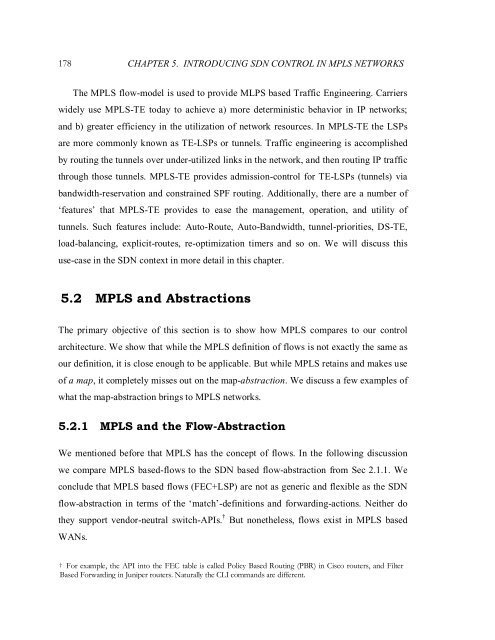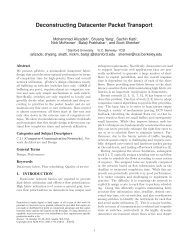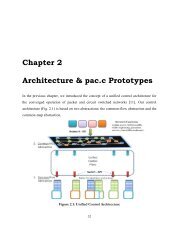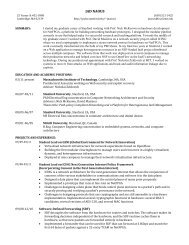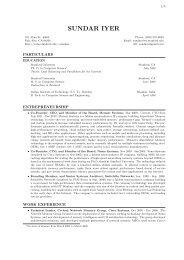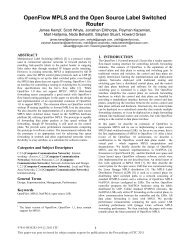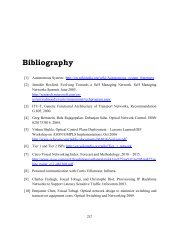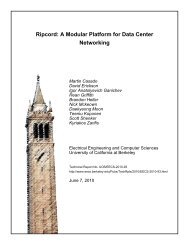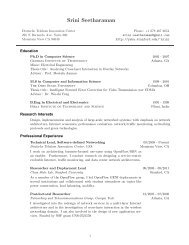Chapter 5 Introducing SDN Control in MPLS Networks - High ...
Chapter 5 Introducing SDN Control in MPLS Networks - High ...
Chapter 5 Introducing SDN Control in MPLS Networks - High ...
Create successful ePaper yourself
Turn your PDF publications into a flip-book with our unique Google optimized e-Paper software.
178 CHAPTER 5. INTRODUCING <strong>SDN</strong> CONTROL IN <strong>MPLS</strong> NETWORKSThe <strong>MPLS</strong> flow-model is used to provide MLPS based Traffic Eng<strong>in</strong>eer<strong>in</strong>g. Carrierswidely use <strong>MPLS</strong>-TE today to achieve a) more determ<strong>in</strong>istic behavior <strong>in</strong> IP networks;and b) greater efficiency <strong>in</strong> the utilization of network resources. In <strong>MPLS</strong>-TE the LSPsare more commonly known as TE-LSPs or tunnels. Traffic eng<strong>in</strong>eer<strong>in</strong>g is accomplishedby rout<strong>in</strong>g the tunnels over under-utilized l<strong>in</strong>ks <strong>in</strong> the network, and then rout<strong>in</strong>g IP trafficthrough those tunnels. <strong>MPLS</strong>-TE provides admission-control for TE-LSPs (tunnels) viabandwidth-reservation and constra<strong>in</strong>ed SPF rout<strong>in</strong>g. Additionally, there are a number of‘features’ that <strong>MPLS</strong>-TE provides to ease the management, operation, and utility oftunnels. Such features <strong>in</strong>clude: Auto-Route, Auto-Bandwidth, tunnel-priorities, DS-TE,load-balanc<strong>in</strong>g, explicit-routes, re-optimization timers and so on. We will discuss thisuse-case <strong>in</strong> the <strong>SDN</strong> context <strong>in</strong> more detail <strong>in</strong> this chapter.5.2 <strong>MPLS</strong> and AbstractionsThe primary objective of this section is to show how <strong>MPLS</strong> compares to our controlarchitecture. We show that while the <strong>MPLS</strong> def<strong>in</strong>ition of flows is not exactly the same asour def<strong>in</strong>ition, it is close enough to be applicable. But while <strong>MPLS</strong> reta<strong>in</strong>s and makes useof a map, it completely misses out on the map-abstraction. We discuss a few examples ofwhat the map-abstraction br<strong>in</strong>gs to <strong>MPLS</strong> networks.5.2.1 <strong>MPLS</strong> and the Flow-AbstractionWe mentioned before that <strong>MPLS</strong> has the concept of flows. In the follow<strong>in</strong>g discussionwe compare <strong>MPLS</strong> based-flows to the <strong>SDN</strong> based flow-abstraction from Sec 2.1.1. Weconclude that <strong>MPLS</strong> based flows (FEC+LSP) are not as generic and flexible as the <strong>SDN</strong>flow-abstraction <strong>in</strong> terms of the ‘match’-def<strong>in</strong>itions and forward<strong>in</strong>g-actions. Neither dothey support vendor-neutral switch-APIs. † But nonetheless, flows exist <strong>in</strong> <strong>MPLS</strong> basedWANs.† For example, the API <strong>in</strong>to the FEC table is called Policy Based Rout<strong>in</strong>g (PBR) <strong>in</strong> Cisco routers, and FilterBased Forward<strong>in</strong>g <strong>in</strong> Juniper routers. Naturally the CLI commands are different.


